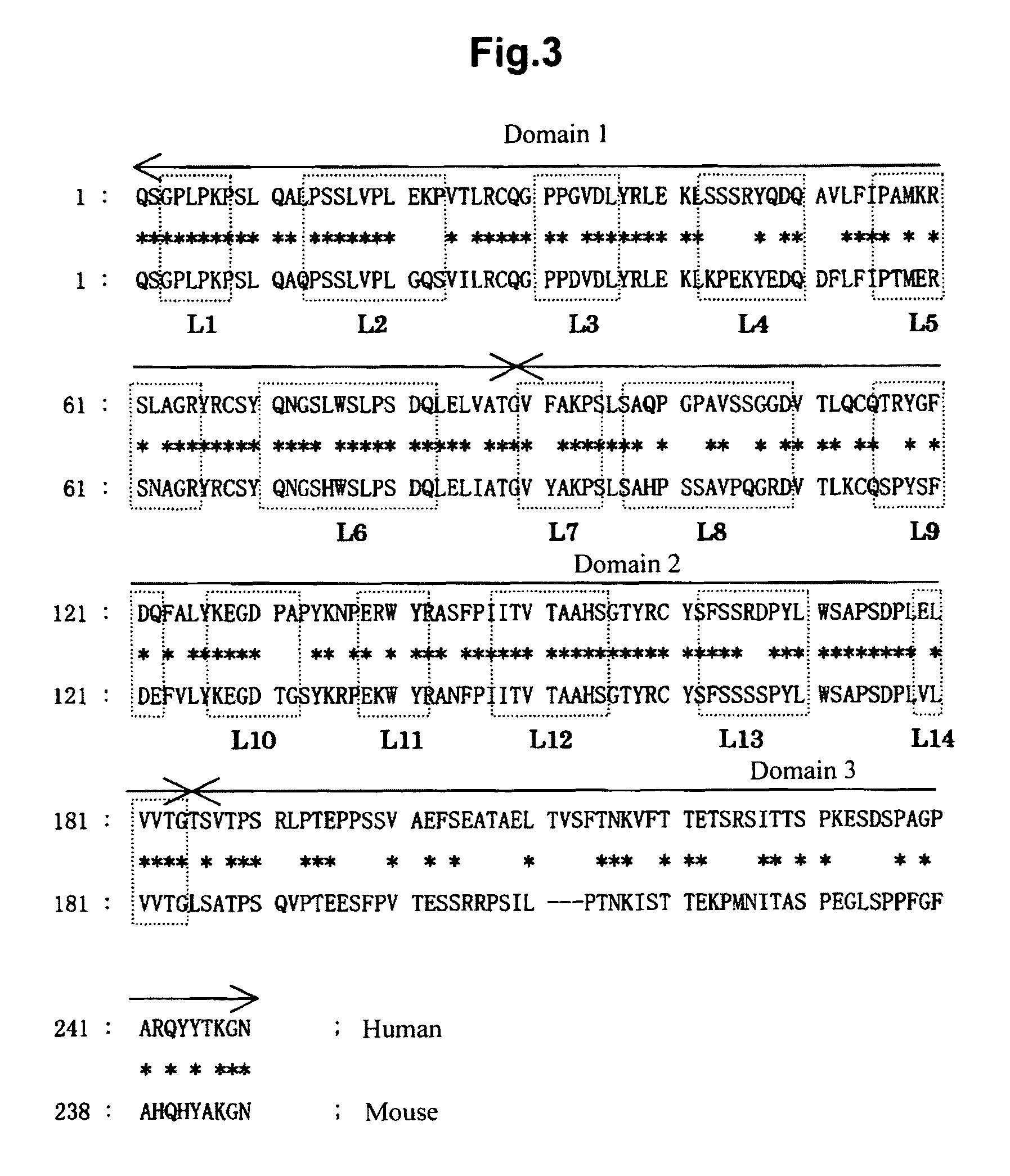Methods of detection GPVI
a technology of platelet activation and detection method, which is applied in the direction of instruments, extracellular fluid disorder, peptide/protein ingredients, etc., can solve the problems of inconsistentness, difficult to obtain consistent, and inability to meet the clinical efficacy of the drug, so as to assess the susceptibility to such a disease and evaluate the risk of developing
- Summary
- Abstract
- Description
- Claims
- Application Information
AI Technical Summary
Benefits of technology
Problems solved by technology
Method used
Image
Examples
example 1
[0199]First of all, primers (6 pairs) capable of amplifying each of the exons of the mouse GPVI gene were designed based on the known data of the mouse GPVI gene. With these primers, PCRs were carried out using rat genomic DNA as the template; the gene fragments that were specifically amplified were sequenced; and the nucleotide sequence of rat GPVI gene was estimated by connecting them. Next, based on this nucleotide sequence data, primers for rat GPVI (ratGPVI-#a, mGPVI-d) were redesigned, and the full-length rat GPVI gene was amplified by PCR using rat bone marrow cDNA (reverse transcripted from rat bone marrow RNA with oligo dT primer) as the template. The amplificated product was extracted from the gel and was cloned into TA-cloning vector pT7-Blue(T) (TAKARA BIO INC.), and its nucleotide sequence was determined. It was confirmed to be the same as the estimated sequence; this plasmid was named pTK-2478. The nucleotide sequence of the rat GPVI gene is...
example 2
Construction of a Rat GPVI (D1D2) Mouse GPVI (D3)-Mouse Fc Fusion Protein (rGPVI-mFc) Expression Plasmid
[0201]Using pTK-2478 as the template, a fragment ‘A’ encoding D1 and D2 of rat GPVI (extracellular domain 1 and domain 2 of GPVI) was amplified by PCR with the primer pair (rat GPVI-#a and rat GPVI-#t). Similarly, using pTK-2440 (described in WO 2006 / 117910 and WO 2006 / 118350) as the template, a fragment ‘B’ encoding D3 of mouse GPVI (region of extracellular domain of GPVI except D1 and D2) was amplified by PCR using the primer pair (rat GPVI-#s and IgG1-i). Then, using a mixture of ‘A’ and ‘B’ as the template, a fragment ‘C’, which was ligated rat GPVI (D1 and D2) and mouse GPVI (D3), was obtained by re-PCR using the primer pair (rat GPVI-#a and IgG1-i). After digestion of the 5′ end of this fragment ‘C’ with Eco RI and the 3′ end with Bam HI, the fragment ‘C’ was inserted into Eco RI and Bam HI sites of the plasmid (pTK-2299: described in WO 2006 / 117910 and WO 2006 / 118350) which...
example 3
Expression and Purification of rGPVI-mFc Fusion Protein
[0204]COS-1 cells were maintained in Dulbecco's MEM culture medium containing 10% fetal bovine serum. After mixing of the transfection reagent (FuGENE6, Roche Diagnostics) and serum-free Dulbecco's MEM culture medium, suitable amount of pTK-2483 was added and mixed, and this mixture was added to COS-1 cells that had been medium-exchanged to Hybridoma-SFM culture medium (Gibco). The supernatant was collected after cultivation for 3 days at 37° C. / 5% CO2; cultivation was then carried out for an additional 3 days in fresh culture medium; and these supernatants were purified with a protein A column (Prosep-vA, Millipore) to yield antigen for use in the preparation of anti-rat GPVI antibody. The obtained rGPVI-mFc fusion protein was subjected to SDS-PAGE analysis by an established method. In brief, the sample and molecular weight markers (Bio-Rad, Precision Plus Protein Unstained Standard) were applied to a 5 to 20% gradient gel foll...
PUM
| Property | Measurement | Unit |
|---|---|---|
| concentration | aaaaa | aaaaa |
| concentration | aaaaa | aaaaa |
| concentration | aaaaa | aaaaa |
Abstract
Description
Claims
Application Information
 Login to View More
Login to View More - R&D
- Intellectual Property
- Life Sciences
- Materials
- Tech Scout
- Unparalleled Data Quality
- Higher Quality Content
- 60% Fewer Hallucinations
Browse by: Latest US Patents, China's latest patents, Technical Efficacy Thesaurus, Application Domain, Technology Topic, Popular Technical Reports.
© 2025 PatSnap. All rights reserved.Legal|Privacy policy|Modern Slavery Act Transparency Statement|Sitemap|About US| Contact US: help@patsnap.com



